An Analysis of Leading Change in Business: PepsiCo and Coca-Cola
VerifiedAdded on 2020/07/22
|13
|3956
|95
Report
AI Summary
This report provides a comprehensive analysis of understanding and leading change within organizations, using PepsiCo and Coca-Cola as comparative case studies. It begins by evaluating the impact of changes on strategies and operations, comparing the two companies' approaches. The report then delves into the impact of internal and external drivers on organizational behavior, examining how factors like mission statements, leadership styles, consumer preferences, and technological advancements influence a company's operations. Furthermore, the report evaluates measures to reduce the negative impacts of changes on firm behavior, emphasizing the importance of leadership and training. It also analyzes barriers to change and their influence on leadership decision-making and explores various leadership approaches in dealing with organizational changes. The report concludes by summarizing key findings and providing recommendations for effective change management, highlighting the dynamic nature of the business environment and the need for adaptability.
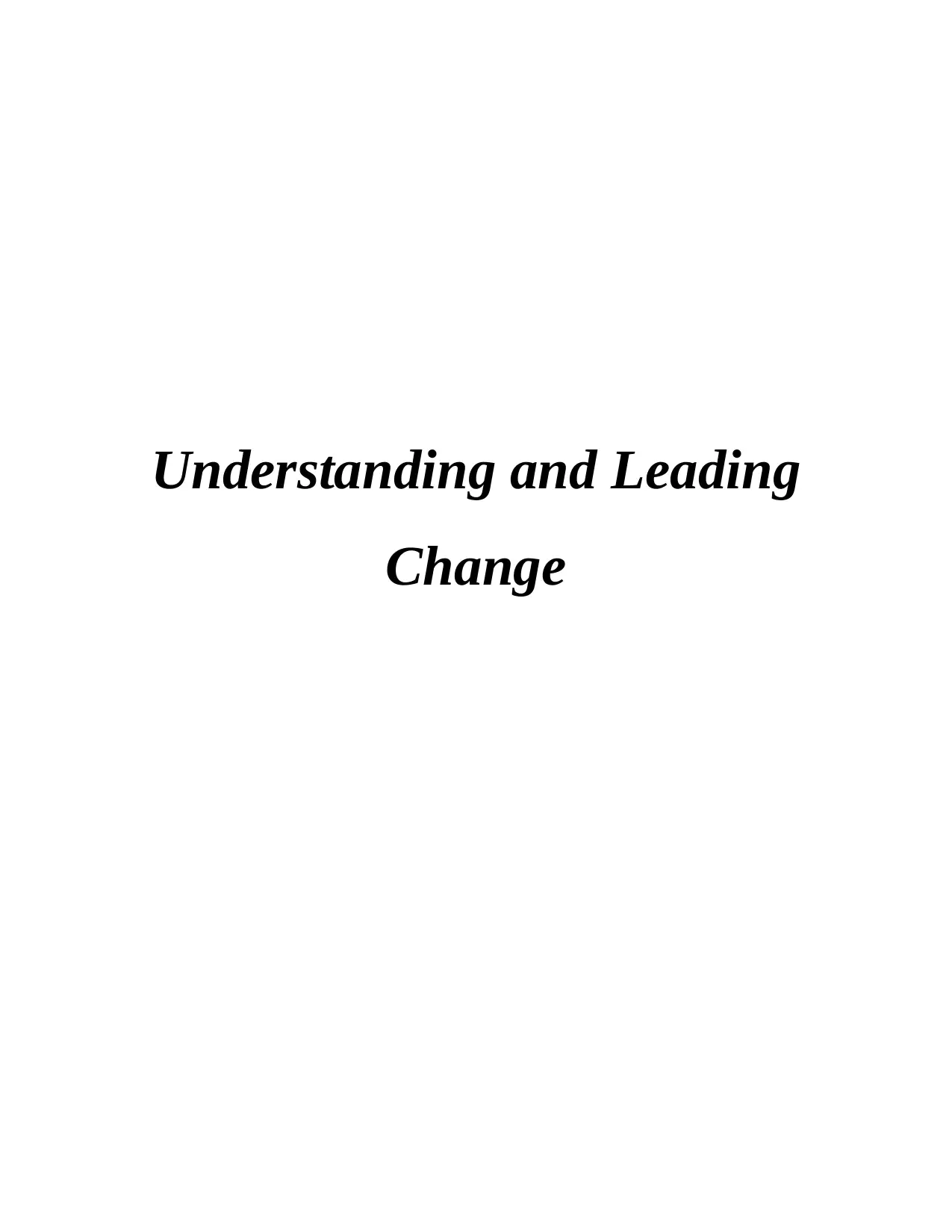
Understanding and Leading
Change
Change
Paraphrase This Document
Need a fresh take? Get an instant paraphrase of this document with our AI Paraphraser
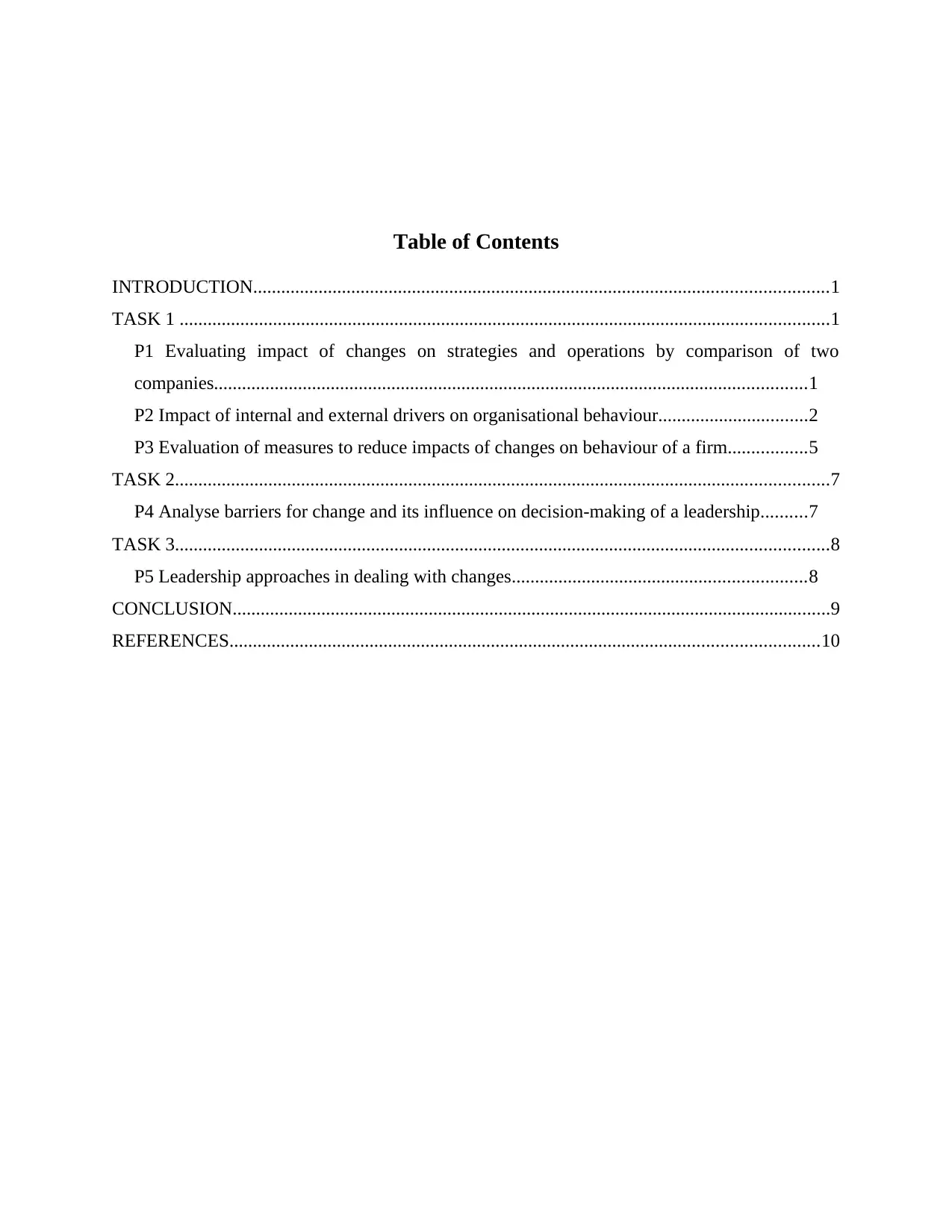
Table of Contents
INTRODUCTION...........................................................................................................................1
TASK 1 ...........................................................................................................................................1
P1 Evaluating impact of changes on strategies and operations by comparison of two
companies...............................................................................................................................1
P2 Impact of internal and external drivers on organisational behaviour................................2
P3 Evaluation of measures to reduce impacts of changes on behaviour of a firm.................5
TASK 2............................................................................................................................................7
P4 Analyse barriers for change and its influence on decision-making of a leadership..........7
TASK 3............................................................................................................................................8
P5 Leadership approaches in dealing with changes...............................................................8
CONCLUSION................................................................................................................................9
REFERENCES..............................................................................................................................10
INTRODUCTION...........................................................................................................................1
TASK 1 ...........................................................................................................................................1
P1 Evaluating impact of changes on strategies and operations by comparison of two
companies...............................................................................................................................1
P2 Impact of internal and external drivers on organisational behaviour................................2
P3 Evaluation of measures to reduce impacts of changes on behaviour of a firm.................5
TASK 2............................................................................................................................................7
P4 Analyse barriers for change and its influence on decision-making of a leadership..........7
TASK 3............................................................................................................................................8
P5 Leadership approaches in dealing with changes...............................................................8
CONCLUSION................................................................................................................................9
REFERENCES..............................................................................................................................10
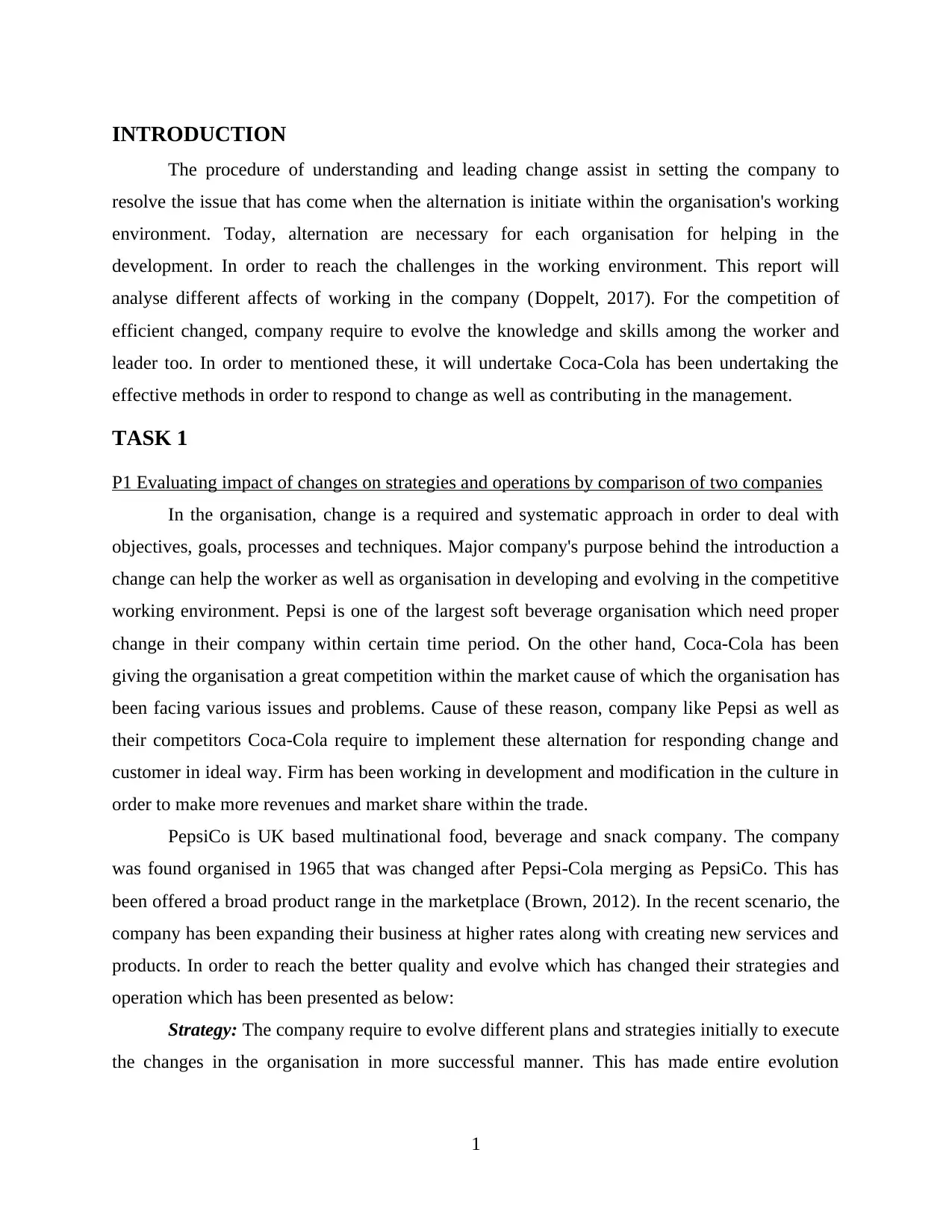
INTRODUCTION
The procedure of understanding and leading change assist in setting the company to
resolve the issue that has come when the alternation is initiate within the organisation's working
environment. Today, alternation are necessary for each organisation for helping in the
development. In order to reach the challenges in the working environment. This report will
analyse different affects of working in the company (Doppelt, 2017). For the competition of
efficient changed, company require to evolve the knowledge and skills among the worker and
leader too. In order to mentioned these, it will undertake Coca-Cola has been undertaking the
effective methods in order to respond to change as well as contributing in the management.
TASK 1
P1 Evaluating impact of changes on strategies and operations by comparison of two companies
In the organisation, change is a required and systematic approach in order to deal with
objectives, goals, processes and techniques. Major company's purpose behind the introduction a
change can help the worker as well as organisation in developing and evolving in the competitive
working environment. Pepsi is one of the largest soft beverage organisation which need proper
change in their company within certain time period. On the other hand, Coca-Cola has been
giving the organisation a great competition within the market cause of which the organisation has
been facing various issues and problems. Cause of these reason, company like Pepsi as well as
their competitors Coca-Cola require to implement these alternation for responding change and
customer in ideal way. Firm has been working in development and modification in the culture in
order to make more revenues and market share within the trade.
PepsiCo is UK based multinational food, beverage and snack company. The company
was found organised in 1965 that was changed after Pepsi-Cola merging as PepsiCo. This has
been offered a broad product range in the marketplace (Brown, 2012). In the recent scenario, the
company has been expanding their business at higher rates along with creating new services and
products. In order to reach the better quality and evolve which has changed their strategies and
operation which has been presented as below:
Strategy: The company require to evolve different plans and strategies initially to execute
the changes in the organisation in more successful manner. This has made entire evolution
1
The procedure of understanding and leading change assist in setting the company to
resolve the issue that has come when the alternation is initiate within the organisation's working
environment. Today, alternation are necessary for each organisation for helping in the
development. In order to reach the challenges in the working environment. This report will
analyse different affects of working in the company (Doppelt, 2017). For the competition of
efficient changed, company require to evolve the knowledge and skills among the worker and
leader too. In order to mentioned these, it will undertake Coca-Cola has been undertaking the
effective methods in order to respond to change as well as contributing in the management.
TASK 1
P1 Evaluating impact of changes on strategies and operations by comparison of two companies
In the organisation, change is a required and systematic approach in order to deal with
objectives, goals, processes and techniques. Major company's purpose behind the introduction a
change can help the worker as well as organisation in developing and evolving in the competitive
working environment. Pepsi is one of the largest soft beverage organisation which need proper
change in their company within certain time period. On the other hand, Coca-Cola has been
giving the organisation a great competition within the market cause of which the organisation has
been facing various issues and problems. Cause of these reason, company like Pepsi as well as
their competitors Coca-Cola require to implement these alternation for responding change and
customer in ideal way. Firm has been working in development and modification in the culture in
order to make more revenues and market share within the trade.
PepsiCo is UK based multinational food, beverage and snack company. The company
was found organised in 1965 that was changed after Pepsi-Cola merging as PepsiCo. This has
been offered a broad product range in the marketplace (Brown, 2012). In the recent scenario, the
company has been expanding their business at higher rates along with creating new services and
products. In order to reach the better quality and evolve which has changed their strategies and
operation which has been presented as below:
Strategy: The company require to evolve different plans and strategies initially to execute
the changes in the organisation in more successful manner. This has made entire evolution
1
⊘ This is a preview!⊘
Do you want full access?
Subscribe today to unlock all pages.

Trusted by 1+ million students worldwide
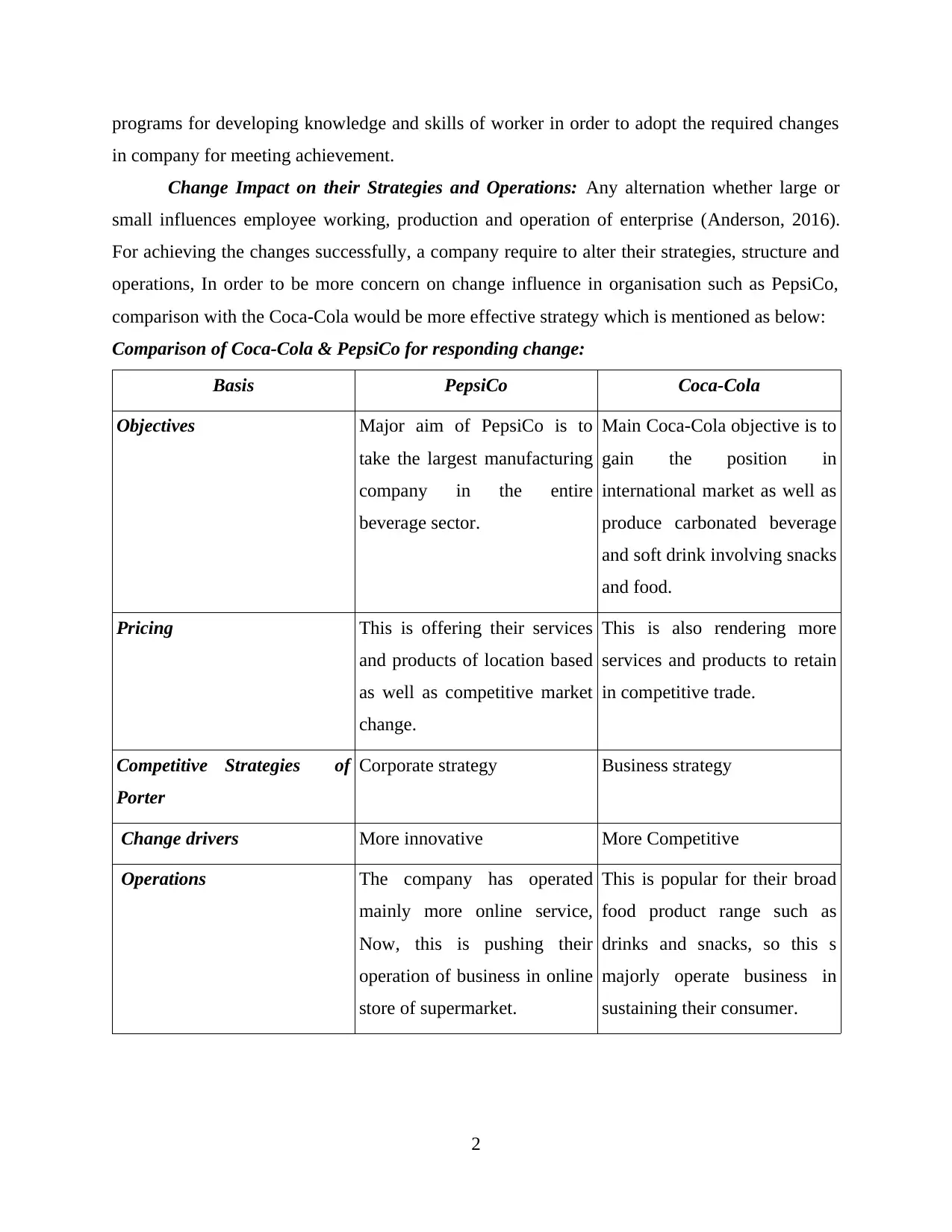
programs for developing knowledge and skills of worker in order to adopt the required changes
in company for meeting achievement.
Change Impact on their Strategies and Operations: Any alternation whether large or
small influences employee working, production and operation of enterprise (Anderson, 2016).
For achieving the changes successfully, a company require to alter their strategies, structure and
operations, In order to be more concern on change influence in organisation such as PepsiCo,
comparison with the Coca-Cola would be more effective strategy which is mentioned as below:
Comparison of Coca-Cola & PepsiCo for responding change:
Basis PepsiCo Coca-Cola
Objectives Major aim of PepsiCo is to
take the largest manufacturing
company in the entire
beverage sector.
Main Coca-Cola objective is to
gain the position in
international market as well as
produce carbonated beverage
and soft drink involving snacks
and food.
Pricing This is offering their services
and products of location based
as well as competitive market
change.
This is also rendering more
services and products to retain
in competitive trade.
Competitive Strategies of
Porter
Corporate strategy Business strategy
Change drivers More innovative More Competitive
Operations The company has operated
mainly more online service,
Now, this is pushing their
operation of business in online
store of supermarket.
This is popular for their broad
food product range such as
drinks and snacks, so this s
majorly operate business in
sustaining their consumer.
2
in company for meeting achievement.
Change Impact on their Strategies and Operations: Any alternation whether large or
small influences employee working, production and operation of enterprise (Anderson, 2016).
For achieving the changes successfully, a company require to alter their strategies, structure and
operations, In order to be more concern on change influence in organisation such as PepsiCo,
comparison with the Coca-Cola would be more effective strategy which is mentioned as below:
Comparison of Coca-Cola & PepsiCo for responding change:
Basis PepsiCo Coca-Cola
Objectives Major aim of PepsiCo is to
take the largest manufacturing
company in the entire
beverage sector.
Main Coca-Cola objective is to
gain the position in
international market as well as
produce carbonated beverage
and soft drink involving snacks
and food.
Pricing This is offering their services
and products of location based
as well as competitive market
change.
This is also rendering more
services and products to retain
in competitive trade.
Competitive Strategies of
Porter
Corporate strategy Business strategy
Change drivers More innovative More Competitive
Operations The company has operated
mainly more online service,
Now, this is pushing their
operation of business in online
store of supermarket.
This is popular for their broad
food product range such as
drinks and snacks, so this s
majorly operate business in
sustaining their consumer.
2
Paraphrase This Document
Need a fresh take? Get an instant paraphrase of this document with our AI Paraphraser
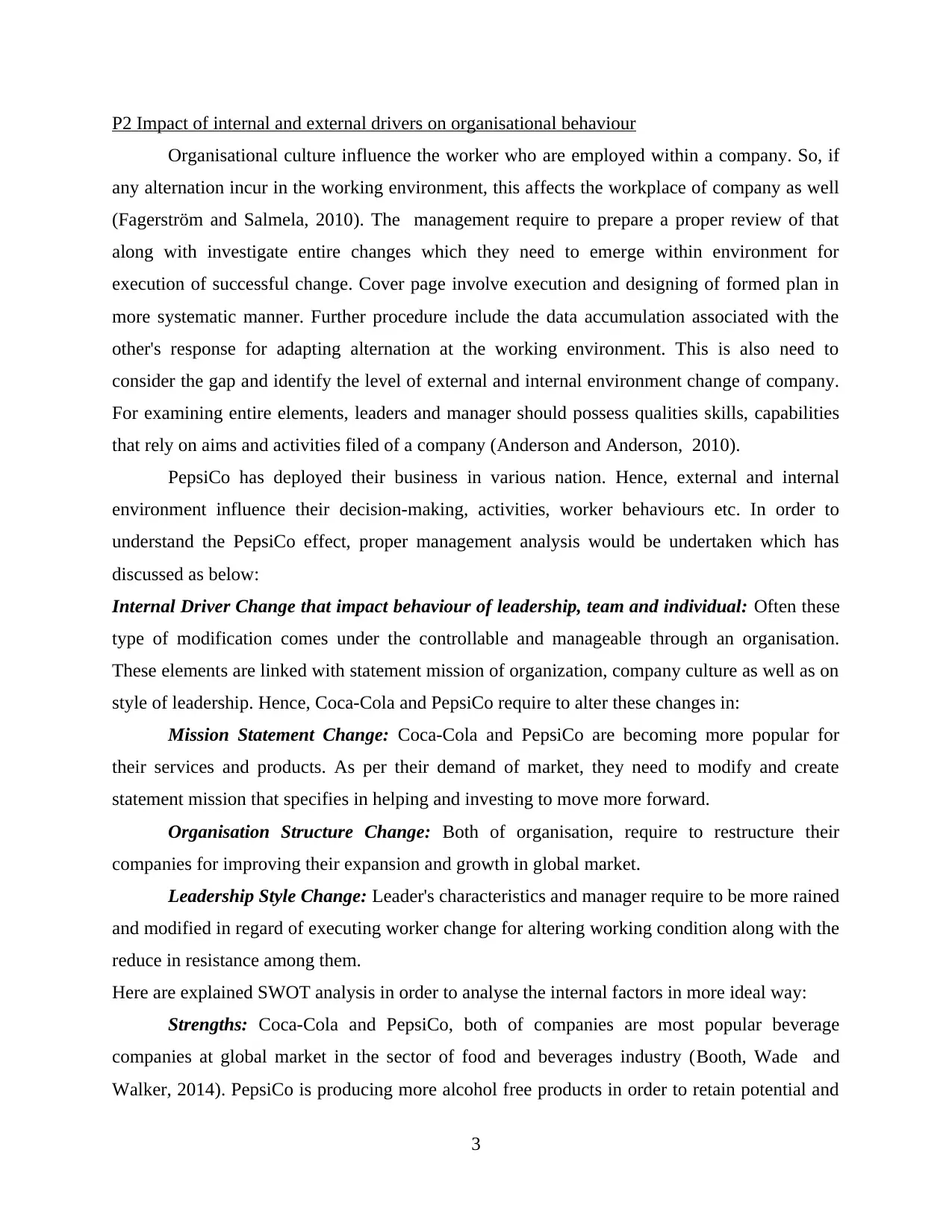
P2 Impact of internal and external drivers on organisational behaviour
Organisational culture influence the worker who are employed within a company. So, if
any alternation incur in the working environment, this affects the workplace of company as well
(Fagerström and Salmela, 2010). The management require to prepare a proper review of that
along with investigate entire changes which they need to emerge within environment for
execution of successful change. Cover page involve execution and designing of formed plan in
more systematic manner. Further procedure include the data accumulation associated with the
other's response for adapting alternation at the working environment. This is also need to
consider the gap and identify the level of external and internal environment change of company.
For examining entire elements, leaders and manager should possess qualities skills, capabilities
that rely on aims and activities filed of a company (Anderson and Anderson, 2010).
PepsiCo has deployed their business in various nation. Hence, external and internal
environment influence their decision-making, activities, worker behaviours etc. In order to
understand the PepsiCo effect, proper management analysis would be undertaken which has
discussed as below:
Internal Driver Change that impact behaviour of leadership, team and individual: Often these
type of modification comes under the controllable and manageable through an organisation.
These elements are linked with statement mission of organization, company culture as well as on
style of leadership. Hence, Coca-Cola and PepsiCo require to alter these changes in:
Mission Statement Change: Coca-Cola and PepsiCo are becoming more popular for
their services and products. As per their demand of market, they need to modify and create
statement mission that specifies in helping and investing to move more forward.
Organisation Structure Change: Both of organisation, require to restructure their
companies for improving their expansion and growth in global market.
Leadership Style Change: Leader's characteristics and manager require to be more rained
and modified in regard of executing worker change for altering working condition along with the
reduce in resistance among them.
Here are explained SWOT analysis in order to analyse the internal factors in more ideal way:
Strengths: Coca-Cola and PepsiCo, both of companies are most popular beverage
companies at global market in the sector of food and beverages industry (Booth, Wade and
Walker, 2014). PepsiCo is producing more alcohol free products in order to retain potential and
3
Organisational culture influence the worker who are employed within a company. So, if
any alternation incur in the working environment, this affects the workplace of company as well
(Fagerström and Salmela, 2010). The management require to prepare a proper review of that
along with investigate entire changes which they need to emerge within environment for
execution of successful change. Cover page involve execution and designing of formed plan in
more systematic manner. Further procedure include the data accumulation associated with the
other's response for adapting alternation at the working environment. This is also need to
consider the gap and identify the level of external and internal environment change of company.
For examining entire elements, leaders and manager should possess qualities skills, capabilities
that rely on aims and activities filed of a company (Anderson and Anderson, 2010).
PepsiCo has deployed their business in various nation. Hence, external and internal
environment influence their decision-making, activities, worker behaviours etc. In order to
understand the PepsiCo effect, proper management analysis would be undertaken which has
discussed as below:
Internal Driver Change that impact behaviour of leadership, team and individual: Often these
type of modification comes under the controllable and manageable through an organisation.
These elements are linked with statement mission of organization, company culture as well as on
style of leadership. Hence, Coca-Cola and PepsiCo require to alter these changes in:
Mission Statement Change: Coca-Cola and PepsiCo are becoming more popular for
their services and products. As per their demand of market, they need to modify and create
statement mission that specifies in helping and investing to move more forward.
Organisation Structure Change: Both of organisation, require to restructure their
companies for improving their expansion and growth in global market.
Leadership Style Change: Leader's characteristics and manager require to be more rained
and modified in regard of executing worker change for altering working condition along with the
reduce in resistance among them.
Here are explained SWOT analysis in order to analyse the internal factors in more ideal way:
Strengths: Coca-Cola and PepsiCo, both of companies are most popular beverage
companies at global market in the sector of food and beverages industry (Booth, Wade and
Walker, 2014). PepsiCo is producing more alcohol free products in order to retain potential and
3
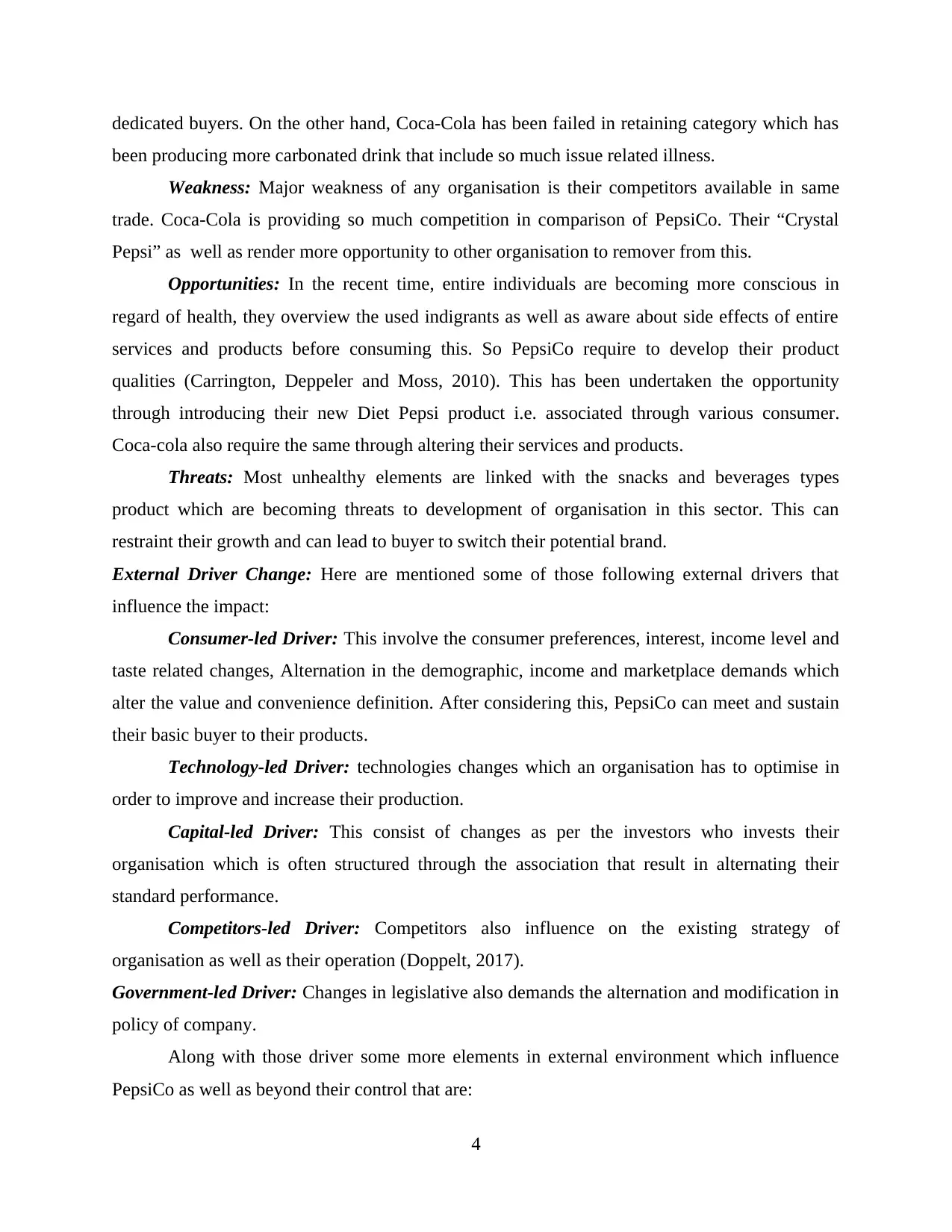
dedicated buyers. On the other hand, Coca-Cola has been failed in retaining category which has
been producing more carbonated drink that include so much issue related illness.
Weakness: Major weakness of any organisation is their competitors available in same
trade. Coca-Cola is providing so much competition in comparison of PepsiCo. Their “Crystal
Pepsi” as well as render more opportunity to other organisation to remover from this.
Opportunities: In the recent time, entire individuals are becoming more conscious in
regard of health, they overview the used indigrants as well as aware about side effects of entire
services and products before consuming this. So PepsiCo require to develop their product
qualities (Carrington, Deppeler and Moss, 2010). This has been undertaken the opportunity
through introducing their new Diet Pepsi product i.e. associated through various consumer.
Coca-cola also require the same through altering their services and products.
Threats: Most unhealthy elements are linked with the snacks and beverages types
product which are becoming threats to development of organisation in this sector. This can
restraint their growth and can lead to buyer to switch their potential brand.
External Driver Change: Here are mentioned some of those following external drivers that
influence the impact:
Consumer-led Driver: This involve the consumer preferences, interest, income level and
taste related changes, Alternation in the demographic, income and marketplace demands which
alter the value and convenience definition. After considering this, PepsiCo can meet and sustain
their basic buyer to their products.
Technology-led Driver: technologies changes which an organisation has to optimise in
order to improve and increase their production.
Capital-led Driver: This consist of changes as per the investors who invests their
organisation which is often structured through the association that result in alternating their
standard performance.
Competitors-led Driver: Competitors also influence on the existing strategy of
organisation as well as their operation (Doppelt, 2017).
Government-led Driver: Changes in legislative also demands the alternation and modification in
policy of company.
Along with those driver some more elements in external environment which influence
PepsiCo as well as beyond their control that are:
4
been producing more carbonated drink that include so much issue related illness.
Weakness: Major weakness of any organisation is their competitors available in same
trade. Coca-Cola is providing so much competition in comparison of PepsiCo. Their “Crystal
Pepsi” as well as render more opportunity to other organisation to remover from this.
Opportunities: In the recent time, entire individuals are becoming more conscious in
regard of health, they overview the used indigrants as well as aware about side effects of entire
services and products before consuming this. So PepsiCo require to develop their product
qualities (Carrington, Deppeler and Moss, 2010). This has been undertaken the opportunity
through introducing their new Diet Pepsi product i.e. associated through various consumer.
Coca-cola also require the same through altering their services and products.
Threats: Most unhealthy elements are linked with the snacks and beverages types
product which are becoming threats to development of organisation in this sector. This can
restraint their growth and can lead to buyer to switch their potential brand.
External Driver Change: Here are mentioned some of those following external drivers that
influence the impact:
Consumer-led Driver: This involve the consumer preferences, interest, income level and
taste related changes, Alternation in the demographic, income and marketplace demands which
alter the value and convenience definition. After considering this, PepsiCo can meet and sustain
their basic buyer to their products.
Technology-led Driver: technologies changes which an organisation has to optimise in
order to improve and increase their production.
Capital-led Driver: This consist of changes as per the investors who invests their
organisation which is often structured through the association that result in alternating their
standard performance.
Competitors-led Driver: Competitors also influence on the existing strategy of
organisation as well as their operation (Doppelt, 2017).
Government-led Driver: Changes in legislative also demands the alternation and modification in
policy of company.
Along with those driver some more elements in external environment which influence
PepsiCo as well as beyond their control that are:
4
⊘ This is a preview!⊘
Do you want full access?
Subscribe today to unlock all pages.

Trusted by 1+ million students worldwide
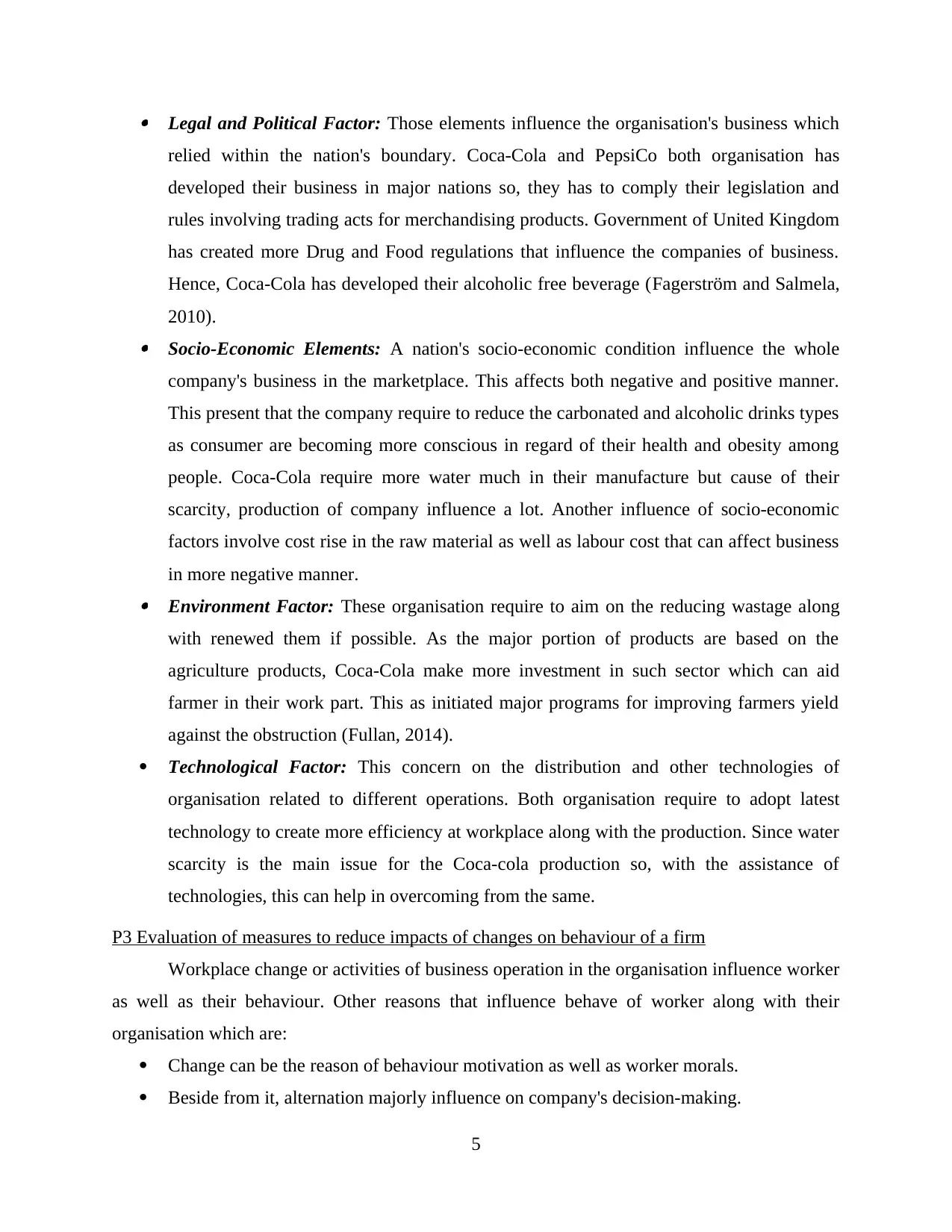
Legal and Political Factor: Those elements influence the organisation's business which
relied within the nation's boundary. Coca-Cola and PepsiCo both organisation has
developed their business in major nations so, they has to comply their legislation and
rules involving trading acts for merchandising products. Government of United Kingdom
has created more Drug and Food regulations that influence the companies of business.
Hence, Coca-Cola has developed their alcoholic free beverage (Fagerström and Salmela,
2010). Socio-Economic Elements: A nation's socio-economic condition influence the whole
company's business in the marketplace. This affects both negative and positive manner.
This present that the company require to reduce the carbonated and alcoholic drinks types
as consumer are becoming more conscious in regard of their health and obesity among
people. Coca-Cola require more water much in their manufacture but cause of their
scarcity, production of company influence a lot. Another influence of socio-economic
factors involve cost rise in the raw material as well as labour cost that can affect business
in more negative manner. Environment Factor: These organisation require to aim on the reducing wastage along
with renewed them if possible. As the major portion of products are based on the
agriculture products, Coca-Cola make more investment in such sector which can aid
farmer in their work part. This as initiated major programs for improving farmers yield
against the obstruction (Fullan, 2014).
Technological Factor: This concern on the distribution and other technologies of
organisation related to different operations. Both organisation require to adopt latest
technology to create more efficiency at workplace along with the production. Since water
scarcity is the main issue for the Coca-cola production so, with the assistance of
technologies, this can help in overcoming from the same.
P3 Evaluation of measures to reduce impacts of changes on behaviour of a firm
Workplace change or activities of business operation in the organisation influence worker
as well as their behaviour. Other reasons that influence behave of worker along with their
organisation which are:
Change can be the reason of behaviour motivation as well as worker morals.
Beside from it, alternation majorly influence on company's decision-making.
5
relied within the nation's boundary. Coca-Cola and PepsiCo both organisation has
developed their business in major nations so, they has to comply their legislation and
rules involving trading acts for merchandising products. Government of United Kingdom
has created more Drug and Food regulations that influence the companies of business.
Hence, Coca-Cola has developed their alcoholic free beverage (Fagerström and Salmela,
2010). Socio-Economic Elements: A nation's socio-economic condition influence the whole
company's business in the marketplace. This affects both negative and positive manner.
This present that the company require to reduce the carbonated and alcoholic drinks types
as consumer are becoming more conscious in regard of their health and obesity among
people. Coca-Cola require more water much in their manufacture but cause of their
scarcity, production of company influence a lot. Another influence of socio-economic
factors involve cost rise in the raw material as well as labour cost that can affect business
in more negative manner. Environment Factor: These organisation require to aim on the reducing wastage along
with renewed them if possible. As the major portion of products are based on the
agriculture products, Coca-Cola make more investment in such sector which can aid
farmer in their work part. This as initiated major programs for improving farmers yield
against the obstruction (Fullan, 2014).
Technological Factor: This concern on the distribution and other technologies of
organisation related to different operations. Both organisation require to adopt latest
technology to create more efficiency at workplace along with the production. Since water
scarcity is the main issue for the Coca-cola production so, with the assistance of
technologies, this can help in overcoming from the same.
P3 Evaluation of measures to reduce impacts of changes on behaviour of a firm
Workplace change or activities of business operation in the organisation influence worker
as well as their behaviour. Other reasons that influence behave of worker along with their
organisation which are:
Change can be the reason of behaviour motivation as well as worker morals.
Beside from it, alternation majorly influence on company's decision-making.
5
Paraphrase This Document
Need a fresh take? Get an instant paraphrase of this document with our AI Paraphraser
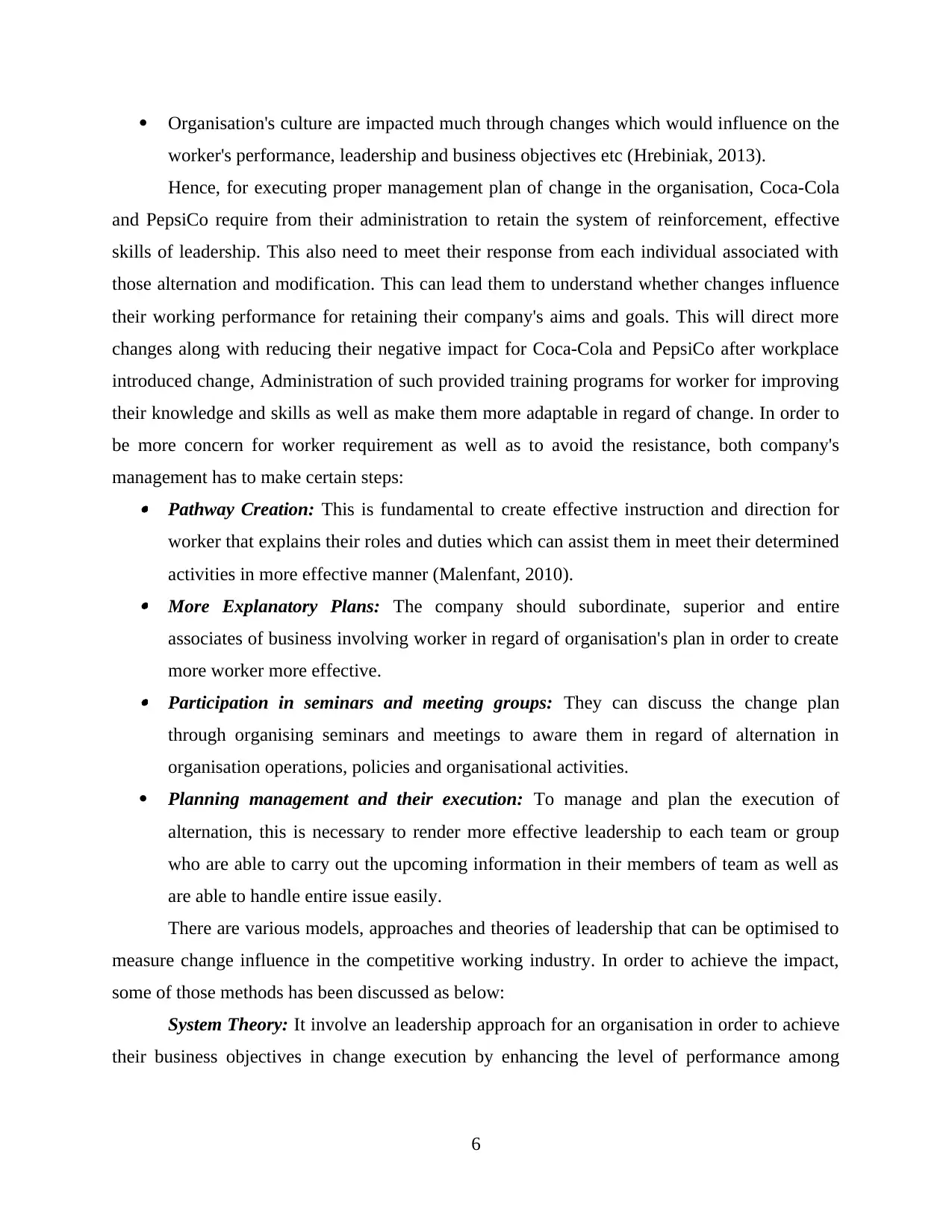
Organisation's culture are impacted much through changes which would influence on the
worker's performance, leadership and business objectives etc (Hrebiniak, 2013).
Hence, for executing proper management plan of change in the organisation, Coca-Cola
and PepsiCo require from their administration to retain the system of reinforcement, effective
skills of leadership. This also need to meet their response from each individual associated with
those alternation and modification. This can lead them to understand whether changes influence
their working performance for retaining their company's aims and goals. This will direct more
changes along with reducing their negative impact for Coca-Cola and PepsiCo after workplace
introduced change, Administration of such provided training programs for worker for improving
their knowledge and skills as well as make them more adaptable in regard of change. In order to
be more concern for worker requirement as well as to avoid the resistance, both company's
management has to make certain steps: Pathway Creation: This is fundamental to create effective instruction and direction for
worker that explains their roles and duties which can assist them in meet their determined
activities in more effective manner (Malenfant, 2010). More Explanatory Plans: The company should subordinate, superior and entire
associates of business involving worker in regard of organisation's plan in order to create
more worker more effective. Participation in seminars and meeting groups: They can discuss the change plan
through organising seminars and meetings to aware them in regard of alternation in
organisation operations, policies and organisational activities.
Planning management and their execution: To manage and plan the execution of
alternation, this is necessary to render more effective leadership to each team or group
who are able to carry out the upcoming information in their members of team as well as
are able to handle entire issue easily.
There are various models, approaches and theories of leadership that can be optimised to
measure change influence in the competitive working industry. In order to achieve the impact,
some of those methods has been discussed as below:
System Theory: It involve an leadership approach for an organisation in order to achieve
their business objectives in change execution by enhancing the level of performance among
6
worker's performance, leadership and business objectives etc (Hrebiniak, 2013).
Hence, for executing proper management plan of change in the organisation, Coca-Cola
and PepsiCo require from their administration to retain the system of reinforcement, effective
skills of leadership. This also need to meet their response from each individual associated with
those alternation and modification. This can lead them to understand whether changes influence
their working performance for retaining their company's aims and goals. This will direct more
changes along with reducing their negative impact for Coca-Cola and PepsiCo after workplace
introduced change, Administration of such provided training programs for worker for improving
their knowledge and skills as well as make them more adaptable in regard of change. In order to
be more concern for worker requirement as well as to avoid the resistance, both company's
management has to make certain steps: Pathway Creation: This is fundamental to create effective instruction and direction for
worker that explains their roles and duties which can assist them in meet their determined
activities in more effective manner (Malenfant, 2010). More Explanatory Plans: The company should subordinate, superior and entire
associates of business involving worker in regard of organisation's plan in order to create
more worker more effective. Participation in seminars and meeting groups: They can discuss the change plan
through organising seminars and meetings to aware them in regard of alternation in
organisation operations, policies and organisational activities.
Planning management and their execution: To manage and plan the execution of
alternation, this is necessary to render more effective leadership to each team or group
who are able to carry out the upcoming information in their members of team as well as
are able to handle entire issue easily.
There are various models, approaches and theories of leadership that can be optimised to
measure change influence in the competitive working industry. In order to achieve the impact,
some of those methods has been discussed as below:
System Theory: It involve an leadership approach for an organisation in order to achieve
their business objectives in change execution by enhancing the level of performance among
6
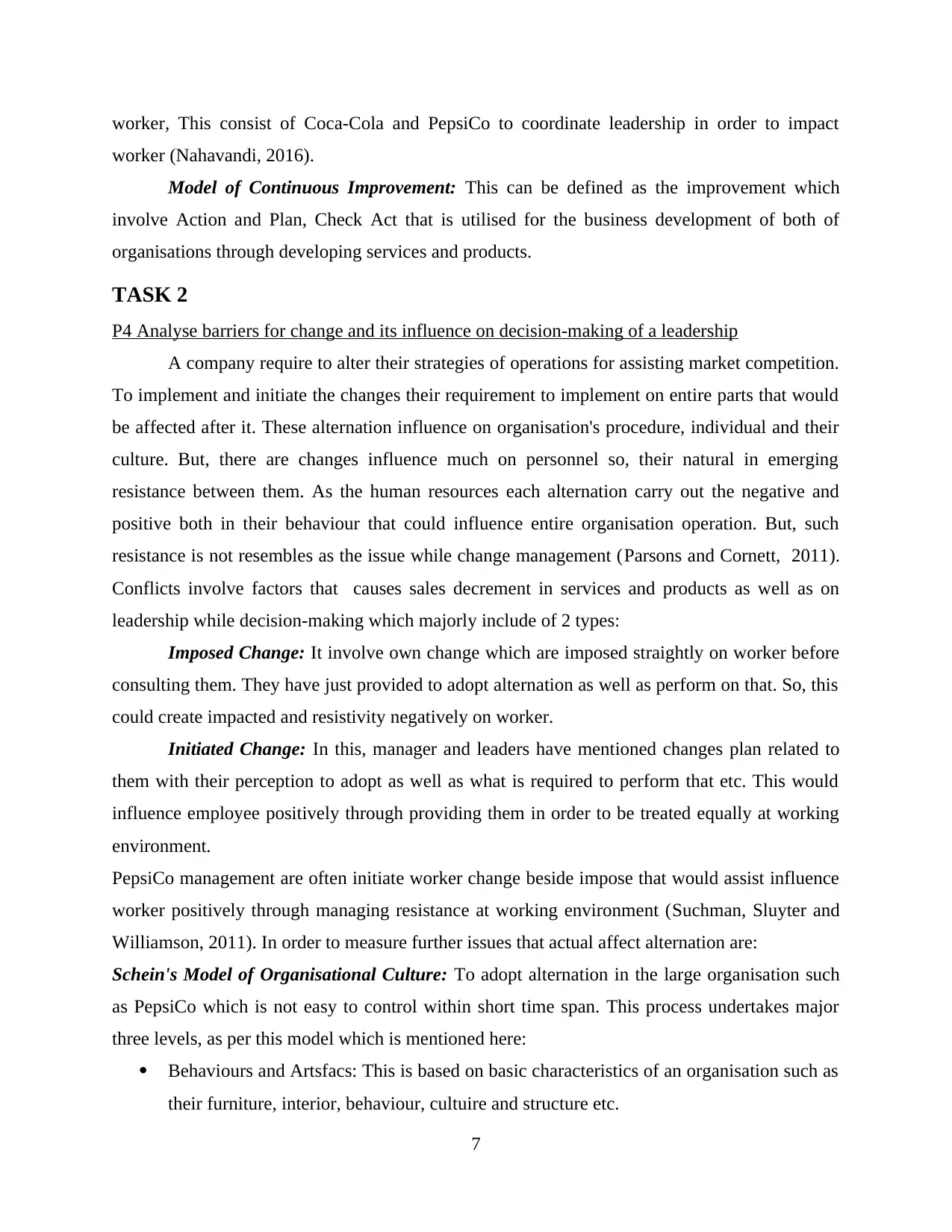
worker, This consist of Coca-Cola and PepsiCo to coordinate leadership in order to impact
worker (Nahavandi, 2016).
Model of Continuous Improvement: This can be defined as the improvement which
involve Action and Plan, Check Act that is utilised for the business development of both of
organisations through developing services and products.
TASK 2
P4 Analyse barriers for change and its influence on decision-making of a leadership
A company require to alter their strategies of operations for assisting market competition.
To implement and initiate the changes their requirement to implement on entire parts that would
be affected after it. These alternation influence on organisation's procedure, individual and their
culture. But, there are changes influence much on personnel so, their natural in emerging
resistance between them. As the human resources each alternation carry out the negative and
positive both in their behaviour that could influence entire organisation operation. But, such
resistance is not resembles as the issue while change management (Parsons and Cornett, 2011).
Conflicts involve factors that causes sales decrement in services and products as well as on
leadership while decision-making which majorly include of 2 types:
Imposed Change: It involve own change which are imposed straightly on worker before
consulting them. They have just provided to adopt alternation as well as perform on that. So, this
could create impacted and resistivity negatively on worker.
Initiated Change: In this, manager and leaders have mentioned changes plan related to
them with their perception to adopt as well as what is required to perform that etc. This would
influence employee positively through providing them in order to be treated equally at working
environment.
PepsiCo management are often initiate worker change beside impose that would assist influence
worker positively through managing resistance at working environment (Suchman, Sluyter and
Williamson, 2011). In order to measure further issues that actual affect alternation are:
Schein's Model of Organisational Culture: To adopt alternation in the large organisation such
as PepsiCo which is not easy to control within short time span. This process undertakes major
three levels, as per this model which is mentioned here:
Behaviours and Artsfacs: This is based on basic characteristics of an organisation such as
their furniture, interior, behaviour, cultuire and structure etc.
7
worker (Nahavandi, 2016).
Model of Continuous Improvement: This can be defined as the improvement which
involve Action and Plan, Check Act that is utilised for the business development of both of
organisations through developing services and products.
TASK 2
P4 Analyse barriers for change and its influence on decision-making of a leadership
A company require to alter their strategies of operations for assisting market competition.
To implement and initiate the changes their requirement to implement on entire parts that would
be affected after it. These alternation influence on organisation's procedure, individual and their
culture. But, there are changes influence much on personnel so, their natural in emerging
resistance between them. As the human resources each alternation carry out the negative and
positive both in their behaviour that could influence entire organisation operation. But, such
resistance is not resembles as the issue while change management (Parsons and Cornett, 2011).
Conflicts involve factors that causes sales decrement in services and products as well as on
leadership while decision-making which majorly include of 2 types:
Imposed Change: It involve own change which are imposed straightly on worker before
consulting them. They have just provided to adopt alternation as well as perform on that. So, this
could create impacted and resistivity negatively on worker.
Initiated Change: In this, manager and leaders have mentioned changes plan related to
them with their perception to adopt as well as what is required to perform that etc. This would
influence employee positively through providing them in order to be treated equally at working
environment.
PepsiCo management are often initiate worker change beside impose that would assist influence
worker positively through managing resistance at working environment (Suchman, Sluyter and
Williamson, 2011). In order to measure further issues that actual affect alternation are:
Schein's Model of Organisational Culture: To adopt alternation in the large organisation such
as PepsiCo which is not easy to control within short time span. This process undertakes major
three levels, as per this model which is mentioned here:
Behaviours and Artsfacs: This is based on basic characteristics of an organisation such as
their furniture, interior, behaviour, cultuire and structure etc.
7
⊘ This is a preview!⊘
Do you want full access?
Subscribe today to unlock all pages.

Trusted by 1+ million students worldwide
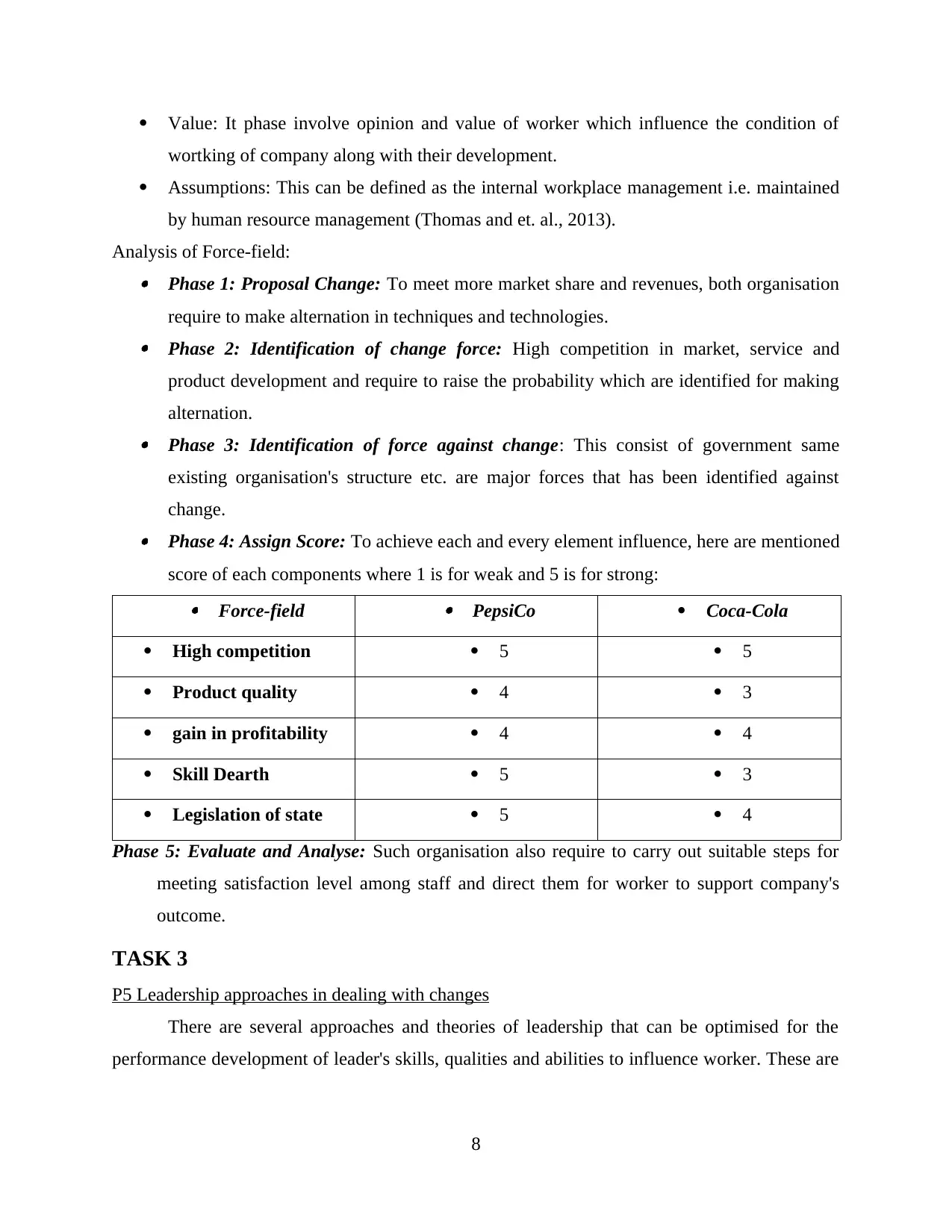
Value: It phase involve opinion and value of worker which influence the condition of
wortking of company along with their development.
Assumptions: This can be defined as the internal workplace management i.e. maintained
by human resource management (Thomas and et. al., 2013).
Analysis of Force-field: Phase 1: Proposal Change: To meet more market share and revenues, both organisation
require to make alternation in techniques and technologies. Phase 2: Identification of change force: High competition in market, service and
product development and require to raise the probability which are identified for making
alternation. Phase 3: Identification of force against change: This consist of government same
existing organisation's structure etc. are major forces that has been identified against
change. Phase 4: Assign Score: To achieve each and every element influence, here are mentioned
score of each components where 1 is for weak and 5 is for strong:
Force-field
PepsiCo Coca-Cola
High competition 5 5
Product quality 4 3
gain in profitability 4 4
Skill Dearth 5 3
Legislation of state 5 4
Phase 5: Evaluate and Analyse: Such organisation also require to carry out suitable steps for
meeting satisfaction level among staff and direct them for worker to support company's
outcome.
TASK 3
P5 Leadership approaches in dealing with changes
There are several approaches and theories of leadership that can be optimised for the
performance development of leader's skills, qualities and abilities to influence worker. These are
8
wortking of company along with their development.
Assumptions: This can be defined as the internal workplace management i.e. maintained
by human resource management (Thomas and et. al., 2013).
Analysis of Force-field: Phase 1: Proposal Change: To meet more market share and revenues, both organisation
require to make alternation in techniques and technologies. Phase 2: Identification of change force: High competition in market, service and
product development and require to raise the probability which are identified for making
alternation. Phase 3: Identification of force against change: This consist of government same
existing organisation's structure etc. are major forces that has been identified against
change. Phase 4: Assign Score: To achieve each and every element influence, here are mentioned
score of each components where 1 is for weak and 5 is for strong:
Force-field
PepsiCo Coca-Cola
High competition 5 5
Product quality 4 3
gain in profitability 4 4
Skill Dearth 5 3
Legislation of state 5 4
Phase 5: Evaluate and Analyse: Such organisation also require to carry out suitable steps for
meeting satisfaction level among staff and direct them for worker to support company's
outcome.
TASK 3
P5 Leadership approaches in dealing with changes
There are several approaches and theories of leadership that can be optimised for the
performance development of leader's skills, qualities and abilities to influence worker. These are
8
Paraphrase This Document
Need a fresh take? Get an instant paraphrase of this document with our AI Paraphraser
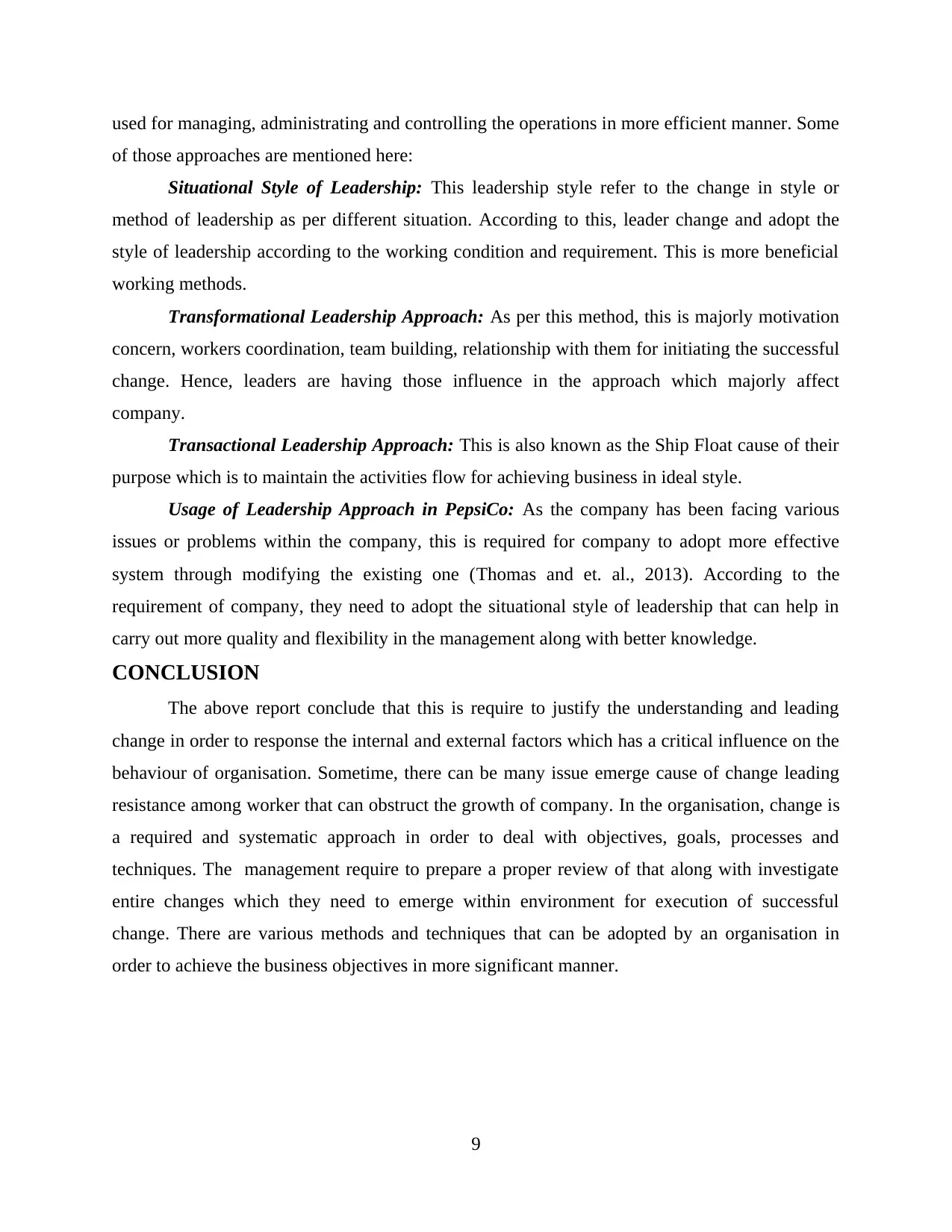
used for managing, administrating and controlling the operations in more efficient manner. Some
of those approaches are mentioned here:
Situational Style of Leadership: This leadership style refer to the change in style or
method of leadership as per different situation. According to this, leader change and adopt the
style of leadership according to the working condition and requirement. This is more beneficial
working methods.
Transformational Leadership Approach: As per this method, this is majorly motivation
concern, workers coordination, team building, relationship with them for initiating the successful
change. Hence, leaders are having those influence in the approach which majorly affect
company.
Transactional Leadership Approach: This is also known as the Ship Float cause of their
purpose which is to maintain the activities flow for achieving business in ideal style.
Usage of Leadership Approach in PepsiCo: As the company has been facing various
issues or problems within the company, this is required for company to adopt more effective
system through modifying the existing one (Thomas and et. al., 2013). According to the
requirement of company, they need to adopt the situational style of leadership that can help in
carry out more quality and flexibility in the management along with better knowledge.
CONCLUSION
The above report conclude that this is require to justify the understanding and leading
change in order to response the internal and external factors which has a critical influence on the
behaviour of organisation. Sometime, there can be many issue emerge cause of change leading
resistance among worker that can obstruct the growth of company. In the organisation, change is
a required and systematic approach in order to deal with objectives, goals, processes and
techniques. The management require to prepare a proper review of that along with investigate
entire changes which they need to emerge within environment for execution of successful
change. There are various methods and techniques that can be adopted by an organisation in
order to achieve the business objectives in more significant manner.
9
of those approaches are mentioned here:
Situational Style of Leadership: This leadership style refer to the change in style or
method of leadership as per different situation. According to this, leader change and adopt the
style of leadership according to the working condition and requirement. This is more beneficial
working methods.
Transformational Leadership Approach: As per this method, this is majorly motivation
concern, workers coordination, team building, relationship with them for initiating the successful
change. Hence, leaders are having those influence in the approach which majorly affect
company.
Transactional Leadership Approach: This is also known as the Ship Float cause of their
purpose which is to maintain the activities flow for achieving business in ideal style.
Usage of Leadership Approach in PepsiCo: As the company has been facing various
issues or problems within the company, this is required for company to adopt more effective
system through modifying the existing one (Thomas and et. al., 2013). According to the
requirement of company, they need to adopt the situational style of leadership that can help in
carry out more quality and flexibility in the management along with better knowledge.
CONCLUSION
The above report conclude that this is require to justify the understanding and leading
change in order to response the internal and external factors which has a critical influence on the
behaviour of organisation. Sometime, there can be many issue emerge cause of change leading
resistance among worker that can obstruct the growth of company. In the organisation, change is
a required and systematic approach in order to deal with objectives, goals, processes and
techniques. The management require to prepare a proper review of that along with investigate
entire changes which they need to emerge within environment for execution of successful
change. There are various methods and techniques that can be adopted by an organisation in
order to achieve the business objectives in more significant manner.
9
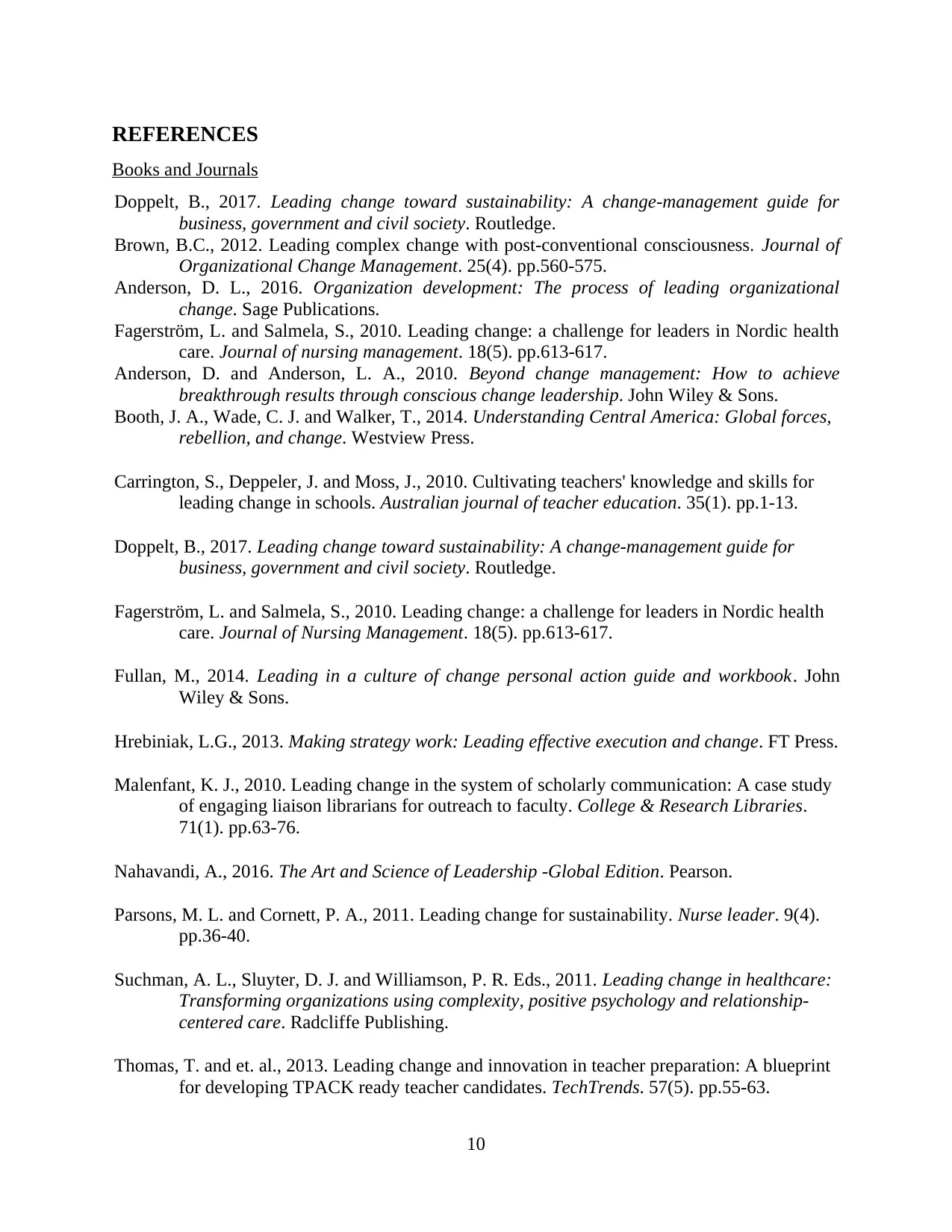
REFERENCES
Books and Journals
Doppelt, B., 2017. Leading change toward sustainability: A change-management guide for
business, government and civil society. Routledge.
Brown, B.C., 2012. Leading complex change with post-conventional consciousness. Journal of
Organizational Change Management. 25(4). pp.560-575.
Anderson, D. L., 2016. Organization development: The process of leading organizational
change. Sage Publications.
Fagerström, L. and Salmela, S., 2010. Leading change: a challenge for leaders in Nordic health
care. Journal of nursing management. 18(5). pp.613-617.
Anderson, D. and Anderson, L. A., 2010. Beyond change management: How to achieve
breakthrough results through conscious change leadership. John Wiley & Sons.
Booth, J. A., Wade, C. J. and Walker, T., 2014. Understanding Central America: Global forces,
rebellion, and change. Westview Press.
Carrington, S., Deppeler, J. and Moss, J., 2010. Cultivating teachers' knowledge and skills for
leading change in schools. Australian journal of teacher education. 35(1). pp.1-13.
Doppelt, B., 2017. Leading change toward sustainability: A change-management guide for
business, government and civil society. Routledge.
Fagerström, L. and Salmela, S., 2010. Leading change: a challenge for leaders in Nordic health
care. Journal of Nursing Management. 18(5). pp.613-617.
Fullan, M., 2014. Leading in a culture of change personal action guide and workbook. John
Wiley & Sons.
Hrebiniak, L.G., 2013. Making strategy work: Leading effective execution and change. FT Press.
Malenfant, K. J., 2010. Leading change in the system of scholarly communication: A case study
of engaging liaison librarians for outreach to faculty. College & Research Libraries.
71(1). pp.63-76.
Nahavandi, A., 2016. The Art and Science of Leadership -Global Edition. Pearson.
Parsons, M. L. and Cornett, P. A., 2011. Leading change for sustainability. Nurse leader. 9(4).
pp.36-40.
Suchman, A. L., Sluyter, D. J. and Williamson, P. R. Eds., 2011. Leading change in healthcare:
Transforming organizations using complexity, positive psychology and relationship-
centered care. Radcliffe Publishing.
Thomas, T. and et. al., 2013. Leading change and innovation in teacher preparation: A blueprint
for developing TPACK ready teacher candidates. TechTrends. 57(5). pp.55-63.
10
Books and Journals
Doppelt, B., 2017. Leading change toward sustainability: A change-management guide for
business, government and civil society. Routledge.
Brown, B.C., 2012. Leading complex change with post-conventional consciousness. Journal of
Organizational Change Management. 25(4). pp.560-575.
Anderson, D. L., 2016. Organization development: The process of leading organizational
change. Sage Publications.
Fagerström, L. and Salmela, S., 2010. Leading change: a challenge for leaders in Nordic health
care. Journal of nursing management. 18(5). pp.613-617.
Anderson, D. and Anderson, L. A., 2010. Beyond change management: How to achieve
breakthrough results through conscious change leadership. John Wiley & Sons.
Booth, J. A., Wade, C. J. and Walker, T., 2014. Understanding Central America: Global forces,
rebellion, and change. Westview Press.
Carrington, S., Deppeler, J. and Moss, J., 2010. Cultivating teachers' knowledge and skills for
leading change in schools. Australian journal of teacher education. 35(1). pp.1-13.
Doppelt, B., 2017. Leading change toward sustainability: A change-management guide for
business, government and civil society. Routledge.
Fagerström, L. and Salmela, S., 2010. Leading change: a challenge for leaders in Nordic health
care. Journal of Nursing Management. 18(5). pp.613-617.
Fullan, M., 2014. Leading in a culture of change personal action guide and workbook. John
Wiley & Sons.
Hrebiniak, L.G., 2013. Making strategy work: Leading effective execution and change. FT Press.
Malenfant, K. J., 2010. Leading change in the system of scholarly communication: A case study
of engaging liaison librarians for outreach to faculty. College & Research Libraries.
71(1). pp.63-76.
Nahavandi, A., 2016. The Art and Science of Leadership -Global Edition. Pearson.
Parsons, M. L. and Cornett, P. A., 2011. Leading change for sustainability. Nurse leader. 9(4).
pp.36-40.
Suchman, A. L., Sluyter, D. J. and Williamson, P. R. Eds., 2011. Leading change in healthcare:
Transforming organizations using complexity, positive psychology and relationship-
centered care. Radcliffe Publishing.
Thomas, T. and et. al., 2013. Leading change and innovation in teacher preparation: A blueprint
for developing TPACK ready teacher candidates. TechTrends. 57(5). pp.55-63.
10
⊘ This is a preview!⊘
Do you want full access?
Subscribe today to unlock all pages.

Trusted by 1+ million students worldwide
1 out of 13
Related Documents
Your All-in-One AI-Powered Toolkit for Academic Success.
+13062052269
info@desklib.com
Available 24*7 on WhatsApp / Email
![[object Object]](/_next/static/media/star-bottom.7253800d.svg)
Unlock your academic potential
Copyright © 2020–2025 A2Z Services. All Rights Reserved. Developed and managed by ZUCOL.





